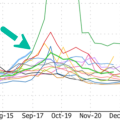The city of Torbat-e Jam is famed for the acres of colourful crocus fields that yield one of Iran’s most prized exports: saffron. But for Reza, a local farmer heaving bags of the orange-red spice into the city’s bustling spice exchange, this year has been a disaster.
“My family harvested only 900kg this season, down from 1,500kg,” he said, blaming bad weather for decimating his precious crop.
More than nine-tenths of the world’s saffron comes from Iran. It is known as “desert gold” due to its ability to thrive in drier climates and prized for its powerful aroma, rich flavour and deep colour.
But changing weather patterns and water shortages are having a dramatic effect on the industry, according to producers and traders, leading to significant falls in yields that have pushed the price of the world’s most expensive spice to fresh highs.
Growers in the Khorasan region that includes Torbat-e Jam said this year’s yields would be less than half those of 2022. “Total production is expected to fall to about 170 tonnes from nearly 400 tonnes,” said Ali Shariati-Moghaddam, chief executive of Novin Saffron, a leading Iranian producer and exporter.
Mojtaba Payam-Asgari, a director at the Torbat-e Jam saffron exchange, said a freezing winter followed by a dry spring and summer temperatures that peaked at 50°C had a devastating effect on the region in north-eastern Iran close to the Afghanistan border. “All 2,000 local surface wells went completely dry,” he said.

Experts warn that such extremes are not a one-off but the result of climate change that is altering weather patterns around the world.
“Iran is more vulnerable than the global average, especially in arid and semi-arid areas [where saffron is grown],” said Mohammad Darvish, an Iranian environmentalist. “Rainfall is declining, and evaporation and temperatures are soaring,” he added.
The price of premium saffron has surged as a result, to $1,400 per kilo domestically, double what it cost last year. The same amount can be $1,800 overseas, according to suppliers.
Saffron is a hallmark of classic Persian cuisine, used in a variety of recipes including rice dish tahchin, stews such as gheimeh and desserts including halva and sholezard.
Some say it has medicinal properties to boost mood, lower blood sugar levels and improve eyesight, memory and heart health. The ancient rulers of Persia gave saffron to soldiers to improve their skills in battle, and scientists are exploring its use in treatments for cancer and depression. The spice is also used as a dye and in cosmetics and perfume.
Its high price is partly down to the labour-intensive nature of the harvest — up to 170,000 flowers are needed to produce 1kg of saffron. The fragile flowers of the crocus sativus are handpicked at dawn in October and November, before its three crimson stigmas are carefully plucked and dried.

The value of Iran’s crop increased over recent decades, as cultivation expanded and new processing methods were introduced. International quality standards were brought in and the saffron exchange launched in 2017. A saffron futures market was set up and an investment fund established.
“The initiative attracted traders and household buyers who traditionally invested in gold and foreign currencies,” said Farhad Saharkhiz, head of Saharkhiz Saffron, which controls almost a third of Iran’s saffron market, and one of those who helped launch the exchange.
The crisis in the industry comes as the Islamic republic grapples with runaway inflation and the effects of western sanctions imposed over its nuclear ambitions that have crippled the economy.
Spice industry leaders fear that domestic consumption — which accounts for about a quarter of annual production — is slumping amid a cost of living crisis, as Iranian consumers struggle with an inflation rate above 40 per cent.
Ahmad Akbari, a dealer in the city of Mashhad, a hub for the saffron trade, said domestic demand had decreased dramatically. “We’re seeing a 50 per cent drop in sales. People’s purchasing power has declined and many can’t afford saffron at current prices.”

Gholamreza Miri, head of Khorasan Razavi Saffron Exporters Union, said US-led sanctions over Iran’s nuclear programme and the consequent curbs on access to the global financial system had also fuelled an illicit saffron trade. “Smugglers sell Iran’s saffron at lower rates to other countries, where it’s rebranded and sold as their own,” Miri said.
Soaring prices are also affecting exports, including to China, the biggest overseas buyer of Iranian saffron. Chinese buyers snap up 45 per cent of Iran’s saffron crop, while Arab countries, Spain and Italy are also big consumers.
“Many Chinese dealers were shocked by the price surge and left,” said Payam-Asgari of the Torbat-e Jam exchange. “They’ll have to pay even higher prices if they come back,” he added, “because there’s very little crop and the warehouses are empty”.
Saffron accounts for only a small percentage of the total proceeds of Iran’s agricultural output, but it is a lifeline for about 100,000 families living in desert areas such as Khorasan. “For them, saffron cultivation is the best option,” said former agriculture minister Issa Kalantari.
“Families depend on the few kilos of saffron they grow,” added one local dealer. “The government should protect us.”
Climate Capital

Where climate change meets business, markets and politics. Explore the FT’s coverage here.
Are you curious about the FT’s environmental sustainability commitments? Find out more about our science-based targets here


